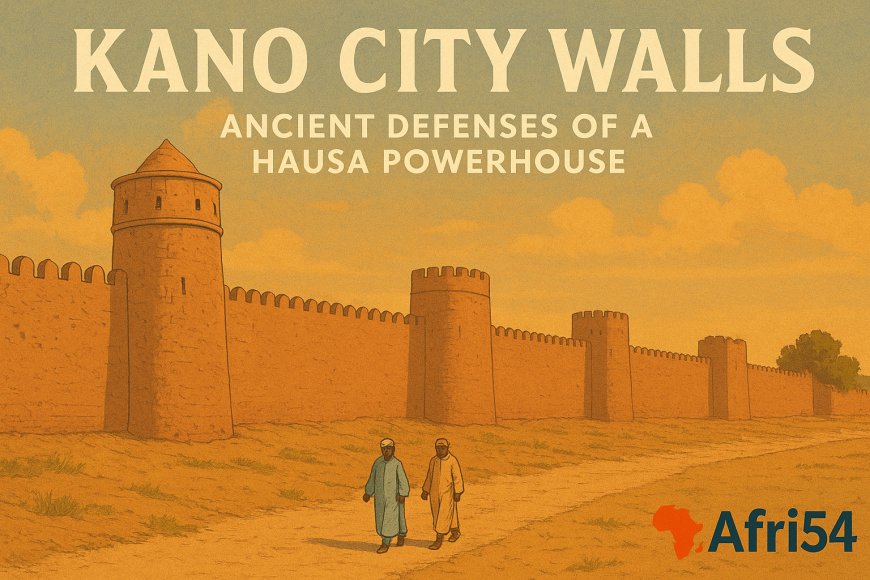Kano City Walls: Ancient Defenses of a Hausa Powerhouse
Discover the Kano City Walls, built between the 11th–14th centuries as the defenses of a great Hausa city-state. Learn about Kano’s role in trade, culture, and West African history.


Reading Time: ~6 minutes
In the heart of northern Nigeria stands one of Africa’s most remarkable man-made structures — the Kano City Walls. Built between the 11th and 14th centuries, these massive earthworks symbolized both the might of the Hausa city-state of Kano and its importance as a center of trade, politics, and culture.
Construction of the walls began under Sarki Gijimasu (ruler of Kano) in the 11th century. Over the centuries, successive rulers expanded and reinforced the fortifications. By the 14th century, the walls stretched over 24 kilometers, encircling the city with a network of gates and defensive towers.
Made primarily of earth and later strengthened with stones, the walls served not only as protection against invaders but also as a symbol of Kano’s political and economic power.
Kano was one of the most important Hausa city-states. Its strategic location at the crossroads of trans-Saharan trade routes made it a hub for merchants dealing in salt, gold, leather, textiles, and kola nuts. The city was also famous for its skilled dye pits, producing indigo-dyed fabrics that were highly valued across West Africa.
Beyond trade, Kano became a center for Islamic scholarship. Mosques and schools flourished inside the city walls, making it not only an economic capital but also an intellectual and religious one.
The walls were more than defensive barriers. They controlled entry into the city through gates (known as “Kofar”), which doubled as points of taxation and security checks for traders. This helped Kano maintain order and generate revenue from its bustling commerce.
The walls also symbolized unity and identity for the people of Kano, marking the boundaries of a community bound together by shared culture and governance.
Though much of the original walls have deteriorated due to time and urban expansion, significant sections still stand. The Kano City Walls are recognized by UNESCO as a cultural heritage site, a reminder of Africa’s architectural ingenuity and urban planning long before colonial times.
Visitors to Kano can still see portions of the walls and gates, alongside other historic sites such as the Emir’s Palace and the ancient Kurmi Market.
The Kano City Walls are more than remnants of the past; they embody the resilience, creativity, and prosperity of Hausa civilization. They stand as testimony to Africa’s long history of urban centers, governance, and thriving trade networks.
The story of the Kano City Walls is the story of a city that stood tall as a beacon of power, trade, and culture in West Africa. It remains a proud symbol of Nigerian heritage and a reminder that Africa’s history is rich with innovation and greatness.
Have you listed your business on Afri54?
Afri54 exists to solve a fundamental challenge faced by millions of African businesses: lack of visibility. Whether you’re an automobile part seller in Lagos, a local attire manufacturer in Kigali, a coffee exporter in Addis Ababa, or a mobile phone supplier in Accra, you deserve to be seen. Join Now
 Like
0
Like
0
 Dislike
0
Dislike
0
 Love
0
Love
0
 Funny
0
Funny
0
 Angry
0
Angry
0
 Sad
0
Sad
0
 Wow
0
Wow
0
Afri54 Sep 19, 2025 0 14
Afri54 Sep 23, 2025 1 12
Afri54 Sep 22, 2025 0 11
Afri54 Sep 23, 2025 0 10
Afri54 Sep 20, 2025 0 9
Afri54 Sep 24, 2025 0 2
Afri54 Sep 24, 2025 0 3
Afri54 Sep 23, 2025 1 3
Afri54 Sep 23, 2025 0 2
Afri54 Sep 23, 2025 0 1
Total Vote: 3
Rebecca Enonchong (Cameroon – AppsTech)
Total Vote: 3
Startup Pitch Competition
Total Vote: 3
Mobile Money & Fintech
Total Vote: 3
Blogs & Articles
Total Vote: 3
Aliko Dangote (Nigeria – Dangote Group)
Total Vote: 3
Fintech
Total Vote: 3
Access to funding
Total Vote: 2
Lagos, Nigeria
Total Vote: 3
Silas Adekunle (Nigeria – Robotics)
Total Vote: 3
Technology & Innovation
Total Vote: 2
Iyinoluwa Aboyeji (Nigeria – Andela & Flutterwave)



